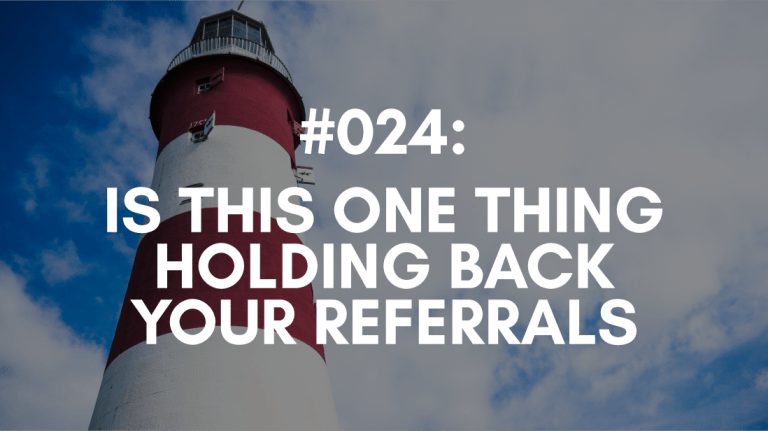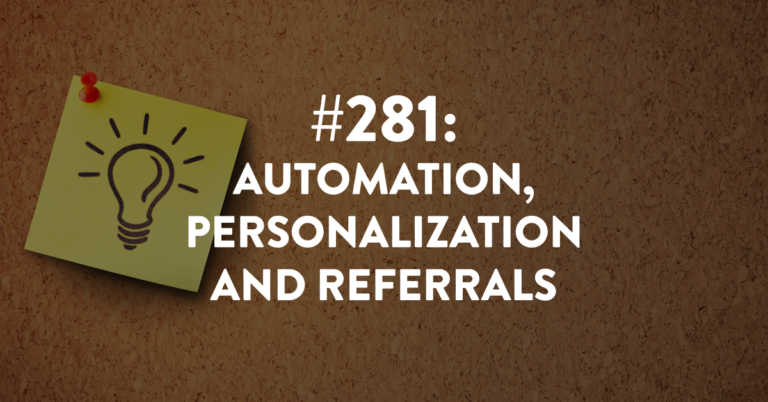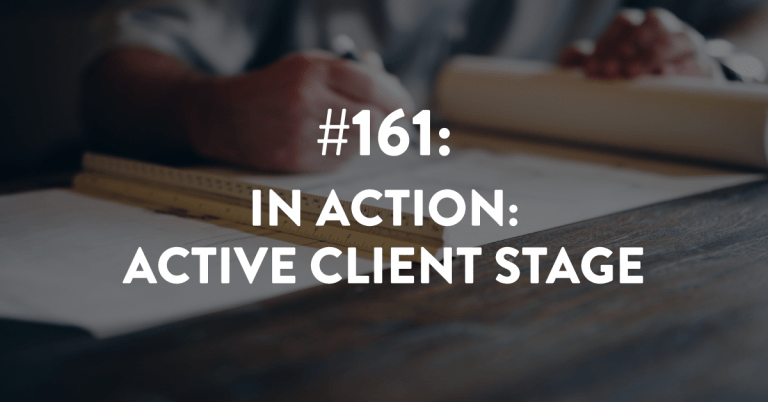Ep #315: How I Solved…Picking a Niche
Jennifer Turney shares her journey of struggling to pick a niche for her business. She highlights the importance of making a decision and sticking with it, even if adjustments may be needed in the future based on market feedback.
Here are some key points from the episode that emphasize the significance of this approach:
Indecisiveness Hinders Progress: Jennifer spent years spinning her wheels and feeling indecisive about choosing a niche. This indecisiveness prevented her from moving forward and focusing her efforts effectively.
Clarity in Messaging: Before deciding on a niche, Jennifer’s messaging was vague and unfocused. She experimented with different ideas and target audiences, leading to a mishmash of generalizations that did not resonate with potential clients.
Market Receptivity: By making a decision and declaring her niche, Jennifer was able to attract the right audience and communicate her value proposition more clearly. This clarity allowed her to connect with individuals who aligned with her services and expertise.
While choosing a niche requires commitment and decisiveness, it is also essential to remain adaptable and open to refining the niche based on market dynamics. Embrace the process, make decisions, and take control of your referrals to build a successful and referable business.
Links Mentioned During the Episode:
Visit Jennifer Ternay’s website
Follow Jennifer on Instagram and LinkedIn
Next Episode:
Next episode is #316, which is another episode created with you and your needs in mind.
Download The Full Episode Transcript
Read the Transcript Below:
Stacey Brown Randall: Two interviews down and a bunch more awesome conversations to go with our summer series, as I interview business owners to fill in the blank of how I solved, and then they share with us how they solved a big problem they had in their business that they didn’t know how to solve to start because it was outside of their zone of genius. Let’s dive in.
Hey there, and welcome to episode 315 of the Roadmap to Referrals podcast, a show about helping you build a referable business. I’m your host, Stacey Brown Randall. My journey from a business failure to a successful business now 10 years in, I know generating referrals naturally and consistently has made all the difference. Working with clients around the world, we leverage the science of referrals, protect relationships above all else, and help you build a referable business.
I am very excited to welcome somebody brand new to the podcast. We have Jennifer with us today, Jennifer Ternay, and she is going to talk about how she solved a problem of picking a niche.
Niche, niche, I say niche. You say it how you want to say it. It’s all good, tomato or tomato. So she’s going to talk about how she solved the problem of really deciding, okay, I’m going to pick a niche, and this is what I’m going to do, and this is what I’m going to focus on.
And I love how she kind of went through the whole, like, I’m in, I’m not. I’m in, I’m not, right? Like, we all do that when we’re like, we’re picking a niche. For some folks, it’s actually quite scary.
It comes from, I think, a little bit of that idea that I want to be able to work with anybody who wants to give me money when you’re first starting your business. But eventually, you will aspire to really hone in who you can and want to work with.
I know for me when people show up, like they submit an application for my BRB program or to work with me as a VIP, and I look at their application, I know like it is it is very clear screaming very loudly from my gut. Yep. Got them. I can help them. Let’s do this.
Or it’s the opposite of that, and it’s like nope. Out of my zone of genius, out of where I want to work, and not an industry I know that well, and I’m going to not be able to be 110, a million amazing percent for them. And so I’ll tell them no.
So knowing who you can help and who you can’t help and picking that niche and sticking with it and then declaring it, you know, in your marketing and in your LinkedIn profile and all the other places, it’s important.
And so I love that Jennifer is here to walk us through how she did it. So let’s dive in.
Stacey Brown Randall: Jennifer, I am so excited to have you come on the podcast. I think this topic that we’re going to talk about is really important. And I think it is kind of like a beast that people deal with. It’s kind of like that, a ball and chain that kind of drags them around when they’re starting a business.
And even when, it doesn’t matter, sometimes when they’re five, you know, six, seven years into it. I’m so excited to talk about this topic. But before we get into how you solved your problem, why don’t you share with my audience a little bit about you and the work that you do?
Jennifer Ternay: Thanks, Stacey. I’m glad to be here. What I do is I work with people that want to be fractional executives, or maybe they actually have fractional executive practices and support them in growing their business.
So I got into that because I’ve done a lot of it and I’ve been a CEO and CFO coming out of healthcare. So that background has been incredibly helpful to help people make that transition. And I’ve done a lot of fractional work.
Stacey Brown Randall: Yeah, and I feel like fractional is, like 10 years ago, you’d be like, you’re what? And then for a while, it was only fractional CFOs, right? It was like, that was like the thing that it was.
And now I feel like over, I don’t know, I think more than the last five years, but it’s really growing. And I think people are really like, you can be a fractional marketer, right? I mean, there’s so many different things that you can do, and you do it from an operational perspective, right?
Jennifer Ternay: I do both. And I actually have done a lot of work as a fractional CFO. So yes, I definitely was in that market space because that’s the chain that I came up through. I came up through finance, so that’s part of my background.
Stacey Brown Randall: Yeah, I think that’s great. Okay, so we’re going to talk about, as most people know who’ve been listening to the series, that I wanted to talk to everyday business owners who solved a problem that was out of their zone of genius.
So, you know, as people who are listening, they know that like I would, if I were coming on this podcast series, which that would be weird because I’m the host, but I’ll probably do an episode anyway.
But if I were coming on this series, I wouldn’t talk about how I solve my referrals problem because that’s what I sell. And I wanted to have business owners have the opportunity to listen to other business owners solve problems in their business that they didn’t know exactly how to solve from the very beginning because it’s out of their zone of genius.
And for you, this is a lot about you figuring out how to pick a niche. And I think this whole idea of like picking a niche really stresses people out because they’re like, it’s so hard. Like some people believe your niche finds you and other people believe you’ve got to be intentional about it.
And I know when you’re starting a business and you know this, when you’re starting a business, what your business looks like three years from your first year will be entirely different because you evolve as a business owner.
So talk to us a little bit about like the struggle that you had with picking a niche, because you are capable of doing so many things. Like, how did you really, like, where did you really kind of dig into like, this is the problem and I need to figure out how to solve it?
Jennifer Ternay: Yeah, coming from a background where it’s finance and numbers, marketing, I was like, I don’t do marketing. It’s kind of like when I deal with other people and they’re like, I don’t do numbers. I was like, I don’t do marketing. I don’t know anything about this.
And when I started getting into it, I was like, okay, I can handle marketing. But then it came time to pick a niche. And I was like, but I relate to people that are in the finance departments in healthcare. I relate to healthcare owners. I relate to single moms. I have so many different directions I could go. Like, how do I pick just one?
What if I’m excluding somebody that I want to work with? How can I do this? I had really just kept spinning my wheels over and over on this. And It’s a terrible feeling of like being super indecisive because you can’t move forward until you pick a niche.
A niche really isn’t something like you’re committed to forever, as you said, when you start out, but your business changes over a period of time. And then you tend to attract the people that you work best with once you make the decision and start putting material out there and talking online and in circles that you’re in about who it is that you serve and how you serve them best.
Stacey Brown Randall: Yeah, I think that this is one of those problems that every business owner at some point is going to deal with. And it may not be their area of expertise.
Like I feel like when you think about how you’re going to do like niching within your business, like I always told folks when they would be like, what’s your niche? And I was like, my niche is referrals without asking. And they’re like, that’s your subject matter expertise niche. What’s your niche?
You’re like, oh, of like your clients. And I’m like, don’t ask me that question because there’s a, you know, I do have about four or five specific industries that I do a lot of work in, and I love working with them. And I know those industries inside and out.
So, but four or five is not necessarily how they would define a niche because a niche is like one, maybe one or two. And so, I mean, this is the thing I’ve been in business, I’m gonna hit 11 years in business this year. And I’m just like, no, I’m good. These are my people.
And sometimes my different groups have nothing to do with each other. Like people are like, what are the industries you work best in? And I was like, well, there’s four or five of them, but let me tell you how little attorneys have in common with interior designers. But I love both of those groups.
And let me tell you how little coaches and consultants have with real estate agents, but I love them both. But I have found over time of shedding some groups and then really focusing on others.
But I think this idea of honing down, because you’re right, then your messaging becomes very succinct. And then when you talk about who you work with, it’s very, very clear. And I think that helps elevate everything that we’re doing in our business from business development and a marketing and everything perspective.
And you’re right, I think when you talk about spinning your wheels, I think that that is, there’s a lot of bad feelings, I think, when things don’t go well with a business, but feeling like you’re in this place over and over and over again and you’re spinning your wheels, that’s a lot of wasted energy for business owners that we don’t have. We don’t have extra time and energy to waste.
Jennifer Ternay: Yeah, there are so many better things that you could use your time and definitely brain energy, because that’s the type of thing where if you’re sweating details at nighttime, and you’re just getting hung up on things, you’re not going to move forward. And a lot of it just comes down to making a decision.
Stacey Brown Randall: I know, it’s like, it sounds so simple when you just say it, the doing, totally different. Okay. So I have mentioned this before. I have let problems fester for years. So obviously no judgment here. But how long was this a problem for you before you’re like, we are picking a niche, here we go?
Jennifer Ternay: Oh, geez. I messed with this probably for six years and did all kinds of things to try to resolve my dilemma.
Stacey Brown Randall: Okay, so we definitely want to dig in how you did it because the how I think is really important for the listeners to understand if they’re struggling with this or sometimes just listening to someone break down how they solve something. So maybe they can pull some tidbits out of that to apply when they’re solving a different problem in their business.
But I want to talk about the why. What was the thing? Sometimes there’s a catalyst. Sometimes there’s a straw that broke the camel’s back. Other times you just finally declare enough is enough because I’ve been dealing with this for so long. But why did you finally decide like, okay, we are solving this problem?
Stacey Brown Randall: Hey there, pardon the interruption. I hope that you’re enjoying our business series this summer focused on having extraordinary business owners talk about how they solved problems in their business that they didn’t know how to solve because it was out of their zone of genius. Don’t worry, we’ll be back on our topic of referrals when we wrap up this summer series.
Speaking of referrals, though, it is crazy to think that you could be just 90 days away from starting to double, triple, or quadruple your referrals. The roadmap and the support plus the accountability that you need, it’s just waiting on you. It’s all inside my coaching program, Building a Referable Business, which we call BRB for short.
Just go to StaceyBrownRandall.com/referable to learn about the program. And then if you’re interested, click on the link to submit your application. I personally review all applications and I’ll let you know if you’re a fit for the program. Then you can learn more and make your decision. Alright. Now back to the episode.
Jennifer Ternay: Yeah, a lot of it is the enough is enough. I say that it’s kind of got tired of my own BS. Like you make your own drama and not making a decision just meant that I was going off and kind of like the expression when you throw spaghetti on the wall to see what sticks. Well, nothing sticks.
So I realized that I was spending a lot of time and money thinking and not really making decisions. So not putting information out there and not sticking with it really just got to the point where I got tired of my own nonsense.
Stacey Brown Randall: Yeah, I think that when we have problems, sometimes it’s, this is not like a, I hit rock bottom and then I made a decision to change. I think sometimes it really does come down to that. Like I just, I’m not dealing with this anymore.
Like this isn’t going to be something that hangs over my head. So you either solve it or you just completely decide never to pay attention to it again and never let it bother you. And it’s easier just to solve it.
So, okay. So usually when we decide enough is enough, I’m making a decision, for some, in some things we don’t know how to solve it. So we have to go through and we have to research like how we’re going to solve the problem and what ultimately that’s going to look like.
And then other times, it’s just because you’ve been thinking about it so long, the years you think about it, you kind of move yourself to, I’ve kind of probably had this answer for a while, and now I’m just going to commit to it.
Was it both for you? Was it like, I learned about it, studied it, or was it more of like, I’ve been thinking about this so long, I finally know the answer is now I’m gonna actually have the guts to do it. Or was it a combination for you?
Jennifer Ternay: I’d say it’s definitely a combination. I did a lot of studying. I like to read. I like to consume material. I’ve done tons of courses. Everything that you could look up for somebody that comes from sort of a learning perspective.
That’s the path that I went down. I can figure this out on my own. And actually, it came down to having a conversation with somebody that I respect and they’re like, look, this is an easy direction for you to go into. It’s a lot of demand. Why not go after that?
I was like, you know what? You’re absolutely right. I have all of these things. I have notebooks of material where I was jotting down different ideas and things that I’d like to do. And I realized there’s a way that I can just blend them all together.
So just pursuing that market. And it doesn’t mean that I’m giving up on the idea of, I love to do the coaching part and the mindset part, but there’s also a piece where it’s very practical business oriented.
And I would get into the space of, well, I need to make a decision. Like my heart’s in one place, but my head’s in another place. Like, why can’t I do both? And that’s really how I decided to move forward.
Stacey Brown Randall: Yeah. I think that we finally get to a place where we can’t consume any more information on how to solve it. We just have to make the decision to solve it.
But I think you mentioned something really key there is that you actually were writing down thoughts and ideas as you like, just kind of thinking, and I don’t do this a lot. It’s one of those things I wish I was like somebody who journaled, and I wish I was much more consistent with it. And I wish I had like instilled that in my children.
I think it’s kind of hard to instill something in your kids you don’t do yourself, but I wish that was something that I did more. Because anytime I have picked up a notebook and be like, I’m going to be intentional about writing down like, you know, daily or weekly, whatever it is that I’m thinking about or dealing with or what’s going on, I typically find somewhere in my notes, I’ve written the answer without realizing it. I just got to go back and read it.
And I think the fact that you were spending time not only learning how to solve the problem, but writing down how to solve the problem was probably big for you.
Jennifer Ternay: Yeah, just this week I had somebody like, what do you write in that notebook? And then what do you actually do with it? I’m like, it’s just my space to put ideas. And then I find that I can go back and flip through a notebook and find, yes, that I actually wrote down exactly what I want to do. And now it’s just come down to executing it.
Stacey Brown Randall: Yeah, I think that’s great. So for you, solving that problem was you did all the things, the courses, the masterminds, the conversations, the seeking out answers, the journaling your thoughts.
And then it came down to, we’re making this problem go away. And for you, that was, you just made the decision. You had come to the conclusion, right? It took you time and you got there, and you just simply made the decision.
So if you were to define for us, what your niche was prior to making the decision to focus on your niche. I’m looking for like a before and after statement. So like, what would you have said to someone before you had a niche versus now, what do you say to folks when you have a niche? How do you communicate your messaging from pre-niche to now I have a niche? Does that question make sense?
Jennifer Ternay: Yeah, it does. So I would experiment with what I was going to talk about. So I’m not even sure I could go through all the different iterations of who I was trying to attract in it. I think even at one point, I was like, I just want to work with people that want the best life possible. And it’s like, well, that takes you nowhere.
Stacey Brown Randall: Very, very general. Best life possible. What does that mean?
Jennifer Ternay: Yeah, it’s like, okay, so how do I know if you’re the right person? So that’s, I think maybe how I would characterize it is it was just a mishmash of nobody very specific. And I didn’t really know who I wanted to work with.
As opposed to now I can talk about, I work best, I tend to attract people that are either fractional CFOs or want to be fractional CFOs, but also some that move into other positions like HR, even legal, and a lot of that has to do with the background that I’ve had.
And it’s just easier because now I can say, here’s the people that I want to connect with. Here are the people and here are some of the examples of if you hear somebody talking about X, Y, and Z, that it makes it very simple to say, okay, that’s a person that Jennifer should be connected to.
And It just really was, I need to make a decision, stick with it, and just let go of trying to figure out whether or not this is the right group. I know I can help these individuals move forward and see what happens.
Stacey Brown Randall: I love it. Sometimes you just have to have faith and trust and take the leap. You can always go back and change it. I think that’s sometimes what people like, I don’t mean change it like six days later because you got nervous.
But like you can always adjust and shift as the marketplace tells you what actually they want from you and what actually it looks like. So I think that’s really valuable.
Okay, cool. So I want my audience to be able to check you out. So where’s the best place for them to find you if they want to learn more about you and what you do?
Jennifer Ternay: So on Instagram and LinkedIn, I am, my handles are Jennifer Ternay and it’s T-E-R-N-A-Y is my last name. And my website is also JenniferTernay.com. Those are the best places to find me.
Stacey Brown Randall: Awesome. And for my listeners listening, we will definitely link to all of that. You do not have to remember how to spell her last name. We will link to her website and both LinkedIn and Instagram. Go ahead and give her a follow. That would be amazing.
Sometimes it is the best thing you can do is follow people who have done something that you want to solve and just kind of peek around the corner. Right? And just kind of like pay attention to what they’re doing. So thank you so much Jennifer for coming on the podcast and sharing how you solved your niche. I really appreciate it.
Jennifer Ternay: Thanks, Stacey.
Stacey Brown Randall: I am so glad that Jennifer helped us tackle the niche/niche debate regarding picking one for your business. Here’s the thing I did say, and I want to repeat it.
If you are new in business and you’re within your first year or two, please know by year three, your business probably won’t look the same way it looks now. Your zone of genius may be the same, but maybe how you work with clients, what you charge, the parameters, the boundaries, all the things, they’re going to evolve.
I’m almost 11 years into this business, and it’s continuing to evolve. I am continuing to unearth problems in my business. I’m like, crap, I got to go solve that. So just know that if you make the decision to pick a niche, and then you’re like, oh, I’m a year in, and that’s not really what I want to do, you can change your mind. That is the power and the beauty of being a business owner.
Alright, but as a reminder, the show notes where you can connect with Jennifer and listen to the resources that we provided, the show notes for this episode is StaceyBrownRandall.com/315. That is 315 for episode 315. And don’t forget, Stacey has an E.
We’re back with another great episode next week created with you and your needs in mind. Until then, you know what to do, my friend. Take control of your referrals and build a referable business. Bye for now.







